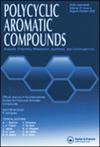Microwave Hantzsch Synthesis of Quinolinyl-Dihydropyridines Supported by Cs-BNT Catalyst and DFT Investigations
IF 2.4
3区 化学
Q2 CHEMISTRY, ORGANIC
引用次数: 0
Abstract
A novel catalyst of cesium-loaded boron nitride (Cs-BNT) was synthesized by stirring the materials at room temperature and was subsequently characterized by the spectroscopic techniques SEM, SEM-EDX, SEM-Mapping, TEM, Brunauer–Emmett–Teller (BET), DSC-TGA, Fourier transform infrared spectroscopy (FT-IR), and Raman spectrum. Furthermore, the catalyst of CsBN layer theoretically analyzed. The microwave method by Cs-BNT was used to synthesize novel heterocyclic quinoline-bearing dihydropyridines 5a-l and subsequently characterized using FT-IR, 1H NMR, 13C NMR, and mass spectrometry. An efficient, recyclable property of the catalyst was recognized, and it was observed that it could show more than five times efficiency in reusability without significant loss of its catalytic activity. The compound diethyl-6-amino-5-cyano-1-(4-fluorophenyl)-4-(2-methoxyquinolin-3-yl)-1,4-dihydropyridine-2,3-dicarboxylate hit compound revealed EHOMO-ELUMO as 4.00 eV indicating high stability of the molecule. The band structure, geometry, DOS, PDOS and Mulliken population based on DFT studies complemented the experimental results.
Cs-BNT 催化剂支持的喹啉基二氢吡啶的微波汉兹合成及 DFT 研究
通过在室温下搅拌材料,合成了一种新型的铯载氮化硼(Cs-BNT)催化剂,随后利用扫描电镜、扫描电镜-EDX、扫描电镜-绘图、TEM、Brunauer-Emmett-Teller(BET)、DSC-TGA、傅立叶变换红外光谱(FT-IR)和拉曼光谱等光谱技术对其进行了表征。此外,还对 CsBN 层催化剂进行了理论分析。利用 Cs-BNT 的微波方法合成了含二氢吡啶的新型杂环喹啉 5a-l,并利用傅立叶变换红外光谱、1H NMR、13C NMR 和质谱对其进行了表征。研究发现,该催化剂具有高效、可回收的特性,其重复利用率可达五倍以上,且催化活性不会明显降低。化合物二乙基-6-氨基-5-氰基-1-(4-氟苯基)-4-(2-甲氧基喹啉-3-基)-1,4-二氢吡啶-2,3-二甲酸酯的 EHOMO-ELUMO 值为 4.00 eV,表明该分子具有很高的稳定性。基于 DFT 研究的能带结构、几何形状、DOS、PDOS 和 Mulliken population 补充了实验结果。
本文章由计算机程序翻译,如有差异,请以英文原文为准。
求助全文
约1分钟内获得全文
求助全文
来源期刊

Polycyclic Aromatic Compounds
化学-有机化学
CiteScore
3.70
自引率
20.80%
发文量
412
审稿时长
3 months
期刊介绍:
The purpose of Polycyclic Aromatic Compounds is to provide an international and interdisciplinary forum for all aspects of research related to polycyclic aromatic compounds (PAC). Topics range from fundamental research in chemistry (including synthetic and theoretical chemistry) and physics (including astrophysics), as well as thermodynamics, spectroscopy, analytical methods, and biology to applied studies in environmental science, biochemistry, toxicology, and industry. Polycyclic Aromatic Compounds has an outstanding Editorial Board and offers a rapid and efficient peer review process, as well as a flexible open access policy.
 求助内容:
求助内容: 应助结果提醒方式:
应助结果提醒方式:


